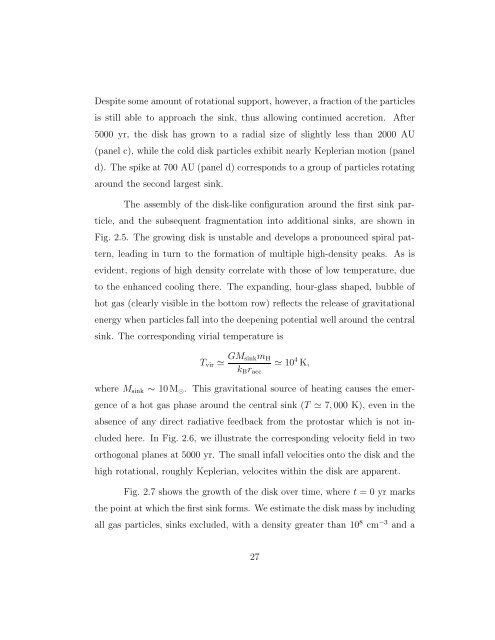Copyright by Athena Ranice Stacy 2011 - The University of Texas at ...
Copyright by Athena Ranice Stacy 2011 - The University of Texas at ...
Copyright by Athena Ranice Stacy 2011 - The University of Texas at ...
Create successful ePaper yourself
Turn your PDF publications into a flip-book with our unique Google optimized e-Paper software.
Despite some amount <strong>of</strong> rot<strong>at</strong>ional support, however, a fraction <strong>of</strong> the particles<br />
is still able to approach the sink, thus allowing continued accretion. After<br />
5000 yr, the disk has grown to a radial size <strong>of</strong> slightly less than 2000 AU<br />
(panel c), while the cold disk particles exhibit nearly Keplerian motion (panel<br />
d). <strong>The</strong> spike <strong>at</strong> 700 AU (panel d) corresponds to a group <strong>of</strong> particles rot<strong>at</strong>ing<br />
around the second largest sink.<br />
<strong>The</strong> assembly <strong>of</strong> the disk-like configur<strong>at</strong>ion around the first sink par-<br />
ticle, and the subsequent fragment<strong>at</strong>ion into additional sinks, are shown in<br />
Fig. 2.5. <strong>The</strong> growing disk is unstable and develops a pronounced spiral p<strong>at</strong>-<br />
tern, leading in turn to the form<strong>at</strong>ion <strong>of</strong> multiple high-density peaks. As is<br />
evident, regions <strong>of</strong> high density correl<strong>at</strong>e with those <strong>of</strong> low temper<strong>at</strong>ure, due<br />
to the enhanced cooling there. <strong>The</strong> expanding, hour-glass shaped, bubble <strong>of</strong><br />
hot gas (clearly visible in the bottom row) reflects the release <strong>of</strong> gravit<strong>at</strong>ional<br />
energy when particles fall into the deepening potential well around the central<br />
sink. <strong>The</strong> corresponding virial temper<strong>at</strong>ure is<br />
Tvir GMsinkmH<br />
kBracc<br />
10 4 K,<br />
where Msink ∼ 10 M⊙. This gravit<strong>at</strong>ional source <strong>of</strong> he<strong>at</strong>ing causes the emer-<br />
gence <strong>of</strong> a hot gas phase around the central sink (T 7, 000 K), even in the<br />
absence <strong>of</strong> any direct radi<strong>at</strong>ive feedback from the protostar which is not in-<br />
cluded here. In Fig. 2.6, we illustr<strong>at</strong>e the corresponding velocity field in two<br />
orthogonal planes <strong>at</strong> 5000 yr. <strong>The</strong> small infall velocities onto the disk and the<br />
high rot<strong>at</strong>ional, roughly Keplerian, velocites within the disk are apparent.<br />
Fig. 2.7 shows the growth <strong>of</strong> the disk over time, where t = 0 yr marks<br />
the point <strong>at</strong> which the first sink forms. We estim<strong>at</strong>e the disk mass <strong>by</strong> including<br />
all gas particles, sinks excluded, with a density gre<strong>at</strong>er than 10 8 cm −3 and a<br />
27









